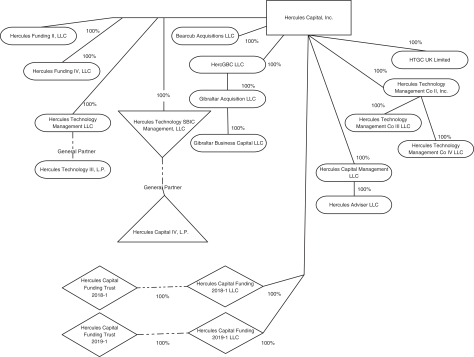Filed Pursuant to Rule 424(b)(2)
Registration No. 333-231089
This preliminary prospectus supplement relates to an effective registration statement under the Securities Act of 1933, as amended, but is not complete and may be changed. This preliminary prospectus supplement is not an offer to sell these securities and it is not soliciting an offer to buy these securities in any state where the offer or sale is not permitted.
SUBJECT TO COMPLETION, DATED SEPTEMBER 13, 2021
PRELIMINARY PROSPECTUS SUPPLEMENT
(To prospectus dated April 29, 2019)
$

% Notes due
We are an internally-managed, non-diversified, closed-end investment company that has elected to be regulated as a business development company under the Investment Company Act of 1940, as amended, or the 1940 Act. Our investment objective is to maximize our portfolio’s total return by generating current income from our debt investments and capital appreciation from our warrant and equity-related investments.
We are offering $ in aggregate principal amount of % notes due , or the “Notes.” The Notes will mature on . We will pay interest on the Notes on and of each year, beginning on , 2022. We may redeem the Notes in whole or in part at any time or from time to time, at the redemption price set forth under “Description of Notes and the Offering—Optional Redemption” in this prospectus supplement. In addition, holders of the Notes can require us to repurchase the Notes at 100% of their principal amount upon the occurrence of a Change of Control Repurchase Event (as defined herein). The Notes will be issued in minimum denominations of $2,000 and integral multiples of $1,000 in excess thereof.
The Notes will be our unsecured obligations and rank pari passu, or equally in right of payment, with all outstanding and future unsecured unsubordinated indebtedness issued by Hercules Capital, Inc.
An investment in the Notes involves risks that are described in the “Supplementary Risk Factors” section beginning on page S-14 in this prospectus supplement, the “Risk Factors” section beginning on page 8 of the accompanying prospectus and in our most recent Annual Report on Form 10-K and Quarterly Report on Form 10-Q, as well as any of our subsequent filings with the Securities and Exchange Commission, or SEC.
This prospectus supplement, the accompanying prospectus, any free writing prospectus related to the offering of the Notes and the documents incorporated by reference herein and therein contain important information you should know before investing in the Notes, including information about the risks related thereto. Please read these documents before investing and retain them for future reference. Additional information about us, including our annual, quarterly and current reports and proxy statements, has been filed with the SEC, and can be accessed free of charge at its website at www.sec.gov. This information is also available free of charge by contacting us at 400 Hamilton Avenue, Suite 310, Palo Alto, California 94301, or by telephone by calling collect at (650) 289-3060 or on our website at www.htgc.com. The information on the websites referred to herein is not incorporated by reference into this prospectus supplement or the accompanying prospectus.
| Per Note | Total | |||||||
| Public offering price(1) |
% | $ | ||||||
| Sales load (underwriting discounts and commissions) |
% | $ | ||||||
| Proceeds to us (before expenses)(2) |
% | $ | ||||||
| (1) | The public offering price set forth above does not include accrued interest, if any. Interest on the Notes will accrue from September , 2021 and must be paid by the purchaser if the Notes are delivered after September , 2021. |
| (2) | Before deducting expenses payable by us related to this offering, estimated at $ . See “Underwriting” in this prospectus supplement for complete details of underwriters’ compensation. |
THE NOTES ARE NOT DEPOSITS OR OTHER OBLIGATIONS OF A BANK AND ARE NOT INSURED BY THE FEDERAL DEPOSIT INSURANCE CORPORATION OR ANY OTHER GOVERNMENT AGENCY.
Neither the SEC nor any state securities commission has approved or disapproved of these securities or determined if this prospectus supplement or the accompanying prospectus is truthful or complete. Any representation to the contrary is a criminal offense.
Delivery of the Notes in book-entry form only through The Depository Trust Company will be made on or about September , 2021.
Joint Book-Running Managers
| Goldman Sachs & Co. LLC | SMBC Nikko | |
| MUFG | RBC Capital Markets |
The date of this prospectus supplement is September , 2021.
